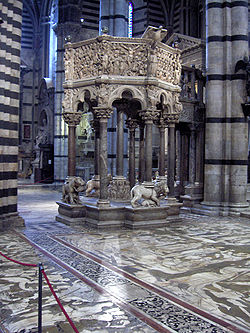
Pulpit (Siena Cathedral)
Encyclopedia

Duomo di Siena
The Cathedral of Siena , dedicated from its earliest days as a Roman Catholic Marian church and now to Santa Maria Assunta , is a medieval church in Siena, central Italy....
was sculpted between the end of 1265 and November 1268 by Nicola Pisano
Nicola Pisano
Nicola Pisano was an Italian sculptor whose work is noted for its classical Roman sculptural style. Pisano is sometimes considered to be the founder of modern sculpture.- Early life :His birth date or origins are uncertain...
with the extensive participation of his son Giovanni Pisano
Giovanni Pisano
Giovanni Pisano was an Italian sculptor, painter and architect. Son of the famous sculptor Nicola Pisano, he received his training in the workshop of his father....
and his assistants Arnolfo di Cambio
Arnolfo di Cambio
Arnolfo di Cambio was an Italian architect and sculptor.-Biography:Arnolfo was born in Colle Val d'Elsa, Tuscany....
, Lapo di Ricevuto and several other artists. It is made of Carrara marble and is the earliest remaining work in the cathedral.
The staircase dates from 1543 and was built by Bartolomeo Neroni.
At the same time, the pulpit was moved from the choir to its present location.
It was raised on a square base, with a rectangular base jutting out on each side
Nicola Pisano was given this commission due to his fame resulting from his Pisa pulpit.
The Siena pulpit, resembling the Pisa pulpit but larger, is even more ambitious and is considered Pisano's masterpiece.
The pulpit expresses in deeper extent the French Gothic style, adopted by him
while still showing a more measured classical Roman influence.
The whole message of the pulpit is concerned with the doctrine of Salvation
Salvation
Within religion salvation is the phenomenon of being saved from the undesirable condition of bondage or suffering experienced by the psyche or soul that has arisen as a result of unskillful or immoral actions generically referred to as sins. Salvation may also be called "deliverance" or...
and the Last Judgment
Last Judgment
The Last Judgment, Final Judgment, Day of Judgment, Judgment Day, or The Day of the Lord in Christian theology, is the final and eternal judgment by God of every nation. The concept is found in all the Canonical gospels, particularly the Gospel of Matthew. It will purportedly take place after the...
.
The seven scenes on the top level of the pulpit explore the theme of salvation.
The colonettes between the panels have been carved into small figures of prophets and angels.
The upper and lower cornices are equally richly carved,
giving the whole a scroll-like reading of the scenes.
(Viewing can be difficult because of the dark interior of the cathedral.)
The seven scenes on the parapet narrate the Life of Christ.
- Visitation and Nativity
- Journey and Adoration of the Magi
- Presentation in the Temple and Flight into Egypt
- Massacre of the Innocents
- Crucifixion
- Last Judgment with the Blessed
- Last Judgment with the Damned
The scenes are crammed with people, leaving no empty spot between the characters.
The many figures in each scene with their chiaroscuro
Chiaroscuro
Chiaroscuro in art is "an Italian term which literally means 'light-dark'. In paintings the description refers to clear tonal contrasts which are often used to suggest the volume and modelling of the subjects depicted"....
effect, show a richness of surface, motion and narrative.
The characters express their emotions and are very aware of the unfolding drama. The faces of the Blessed and the Damned in the Last Judgment panel show realistic expressions.
The different scenes in several panels are set above each other, giving the impression of a certain depth.
Each panel is filled to the top with figures to avoid open spaces:
The pulpit is octagonal in shape.
There are nine columns, made of granite, porphyry and green marble.
Four columns rest on a base, two are supported by lions and two by lionesses, while the central column rests on small statues of the Seven Liberal Arts and Philosophy.
On the middle level, the trefoil arches
Trefoil
Trefoil is a graphic form composed of the outline of three overlapping rings used in architecture and Christian symbolism...
between the eight columns are separated by small statues,
representing the Christian Virtue. In the spandrel
Spandrel
A spandrel, less often spandril or splaundrel, is the space between two arches or between an arch and a rectangular enclosure....
s, the space between the trefoils and the statues,
Pisano has included statuettes of Sibyl
Sibyl
The word Sibyl comes from the Greek word σίβυλλα sibylla, meaning prophetess. The earliest oracular seeresses known as the sibyls of antiquity, "who admittedly are known only through legend" prophesied at certain holy sites, under the divine influence of a deity, originally— at Delphi and...
s, the Evangelist
Four Evangelists
In Christian tradition the Four Evangelists are Matthew, Mark, Luke, and John, the authors attributed with the creation of the four Gospel accounts in the New Testament that bear the following titles:*Gospel according to Matthew*Gospel according to Mark...
s and Prophet
Prophet
In religion, a prophet, from the Greek word προφήτης profitis meaning "foreteller", is an individual who is claimed to have been contacted by the supernatural or the divine, and serves as an intermediary with humanity, delivering this newfound knowledge from the supernatural entity to other people...
s, announcing the salvation of mankind.

